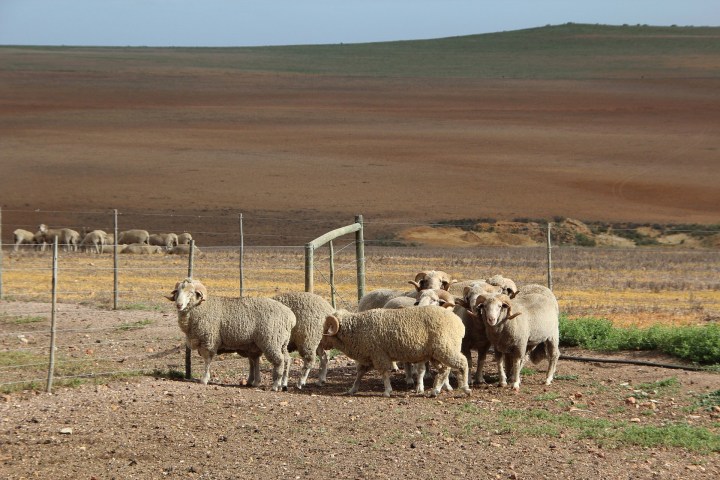MAIN INGREDIENT
The case for mutton

Meat, fat, veld, flavour – that’s mutton, in four words. Lamb? Let it live a little first.
It’s the question that has sheep farmers shaking their heads with wry smiles passing like shadows across their weathered faces: Why do the townies all prefer lamb over mutton?
Lamb is delicious when cooked rare. That is the one thing that the meat of the younger creature has over the wise old sheep. So, a leg of young lamb cooked rare, or a rack of lamb cooked perfectly pink at the centre, will not be trounced by the equivalent cut of the older animal cooked in the same way. But for almost any other dish, mutton wins, every time.
We might be better off seeing lambs and fully grown sheep as different animals; that’s how different their meat is when cooked. For a bredie, it’s mutton you want; especially a tomato bredie which relies on fatty mutton rib cut into pieces. For a lamb or mutton curry, you’re going to get far more flavour out of the latter, as well as the fat that gives a good old Durban curry its special mouthfeel.
Yet, I receive frequent emails from readers wanting to know why they can’t get mutton in their local supermarket meat fridges and butcheries. That, I’m afraid, comes down to nothing more than supply and demand: city folk almost invariably choose lamb, ask for lamb, expect lamb. Until you change that mindset, and start asking in greater numbers for mutton, it is not going to change.
So the solution to the problem lies with the potential customers. Do what I do: start getting to know your butcher and ask them for mutton. Canvass your friends and persuade them to do the same. If you, reading this, are a butcher yourself, take a chance on doing some marketing directly at your customer base, and in posters and brochures in your shop, punting the desirability of mutton for the home cook. If you are a chef, put some mutton on your menu. Draw attention to it by making it the special of the day, or create a mutton signature dish.
When last did you see tomato bredie on a restaurant menu? This is one of our greatest dishes. Done well, it is an utter joy to eat. And to cook; it smells so good on a cold winter’s day as the aromas from the big pot in the kitchen waft through the house. Lamb can be wonderful, but mutton, that is always going to taste better. All it needs is more time.
Conscience can be brought into play too. Reluctant as I am to use the word “kind” in relation to the consumption of meat, I do know that it is kinder to the animal to let it live a longer life and only consign it to the abattoir much later in life. Reluctant, because many of us who choose to eat meat find the branding and marketing of plant-based faux “meat” as “kind” rather condescending, as if to suggest we care nothing for the suffering of animals, whereas we simply accept that meat is a necessary part of the human diet. You may disagree with me; but so may I with you.
I’d like to offer some food for thought on that matter. In the veld on the farms of the Great Karoo, toothless old ewes munch pathetically on karoobossies they can no longer chew. Great numbers of them live full lives, providing the wool that brings the farmer’s two annual wool cheques, and at other times in their younger lives grazing contentedly with their lambs at foot. But once they grow too old even to eat, it is humane to put an end to them. If, therefore, you’re a meat eater with a conscience, as am I, eat mutton; lambs everywhere will rejoice, and live longer lives.
This is not to say I do not or would not eat lamb; I do, and I will, and I do not pretend otherwise. But I would be thrilled if the consumption of mutton became mainstream and even matched the quantity of lamb bought in our city supermarkets and butcheries.
Also, our lambs are often slaughtered (relatively) too old, with the consequence that their meat is neither young enough to be the best possible lamb, nor old enough to have developed the full flavour of mutton. And their meat is overrated (by comparison with mutton) and overpriced. C Louis Leipoldt wrote that “lamb is commonly slaughtered too old, and is not of the same quality [as lamb] though it can be very good indeed”, and I suspect that is still the case today, judging by the size of the legs sold as lamb. A leg of lamb in Britain is generally much smaller, and the New Zealand lamb legs imported by Britain tend to be tiddlers by comparison to ours.
Leipoldt also observed that “well-fed farm sheep are always fat and mutton from them sometimes needs considerable trimming, and certainly never needs larding”. Consider a whole lamb rib or a whole mutton rib cooked slowly at a right angle to braai coals; it’s mutton you want for that, with all those fatty juices dripping down and enriching the meat.
In the Karoo, we prefer mutton chops to lamb on the braai too. “Mutton chops from Karoo sheep are a joy,” the great man wrote. And I never argue with Leipoldt. DM/TGIFood
Tony Jackman is Galliova Food Champion 2021. His book, foodSTUFF, is available in the DM Shop. Buy it here.
Follow Tony Jackman on Instagram @tony_jackman_cooks. Share your versions of his recipes with him on Instagram and he’ll see them and respond.
SUBSCRIBE to TGIFood here. Also visit the TGIFood platform, a repository of all of our food writing.





 Become an Insider
Become an Insider
I grew up in the Free State where we lived on mutton. It was a delectable chilhood. Hoor! hoor!, Tony Jackman!
Sorry, ‘childhood’!